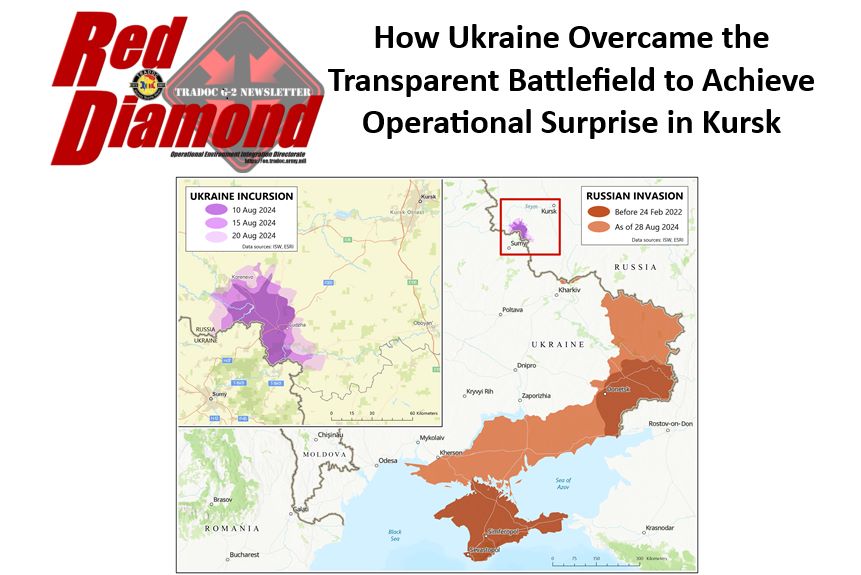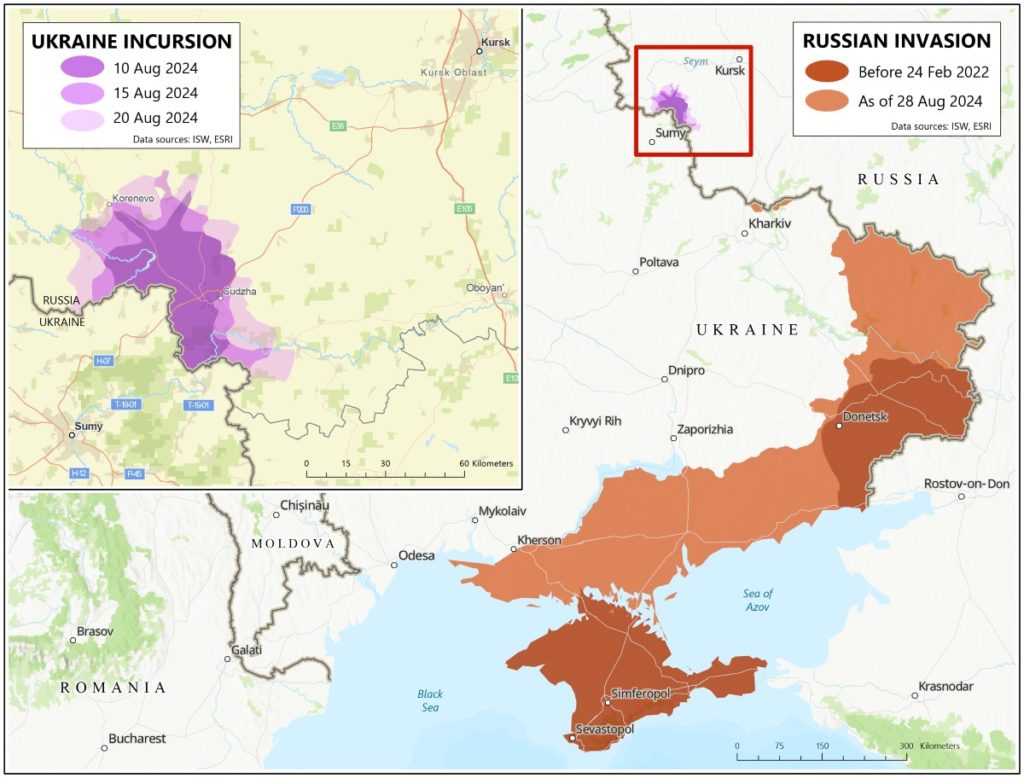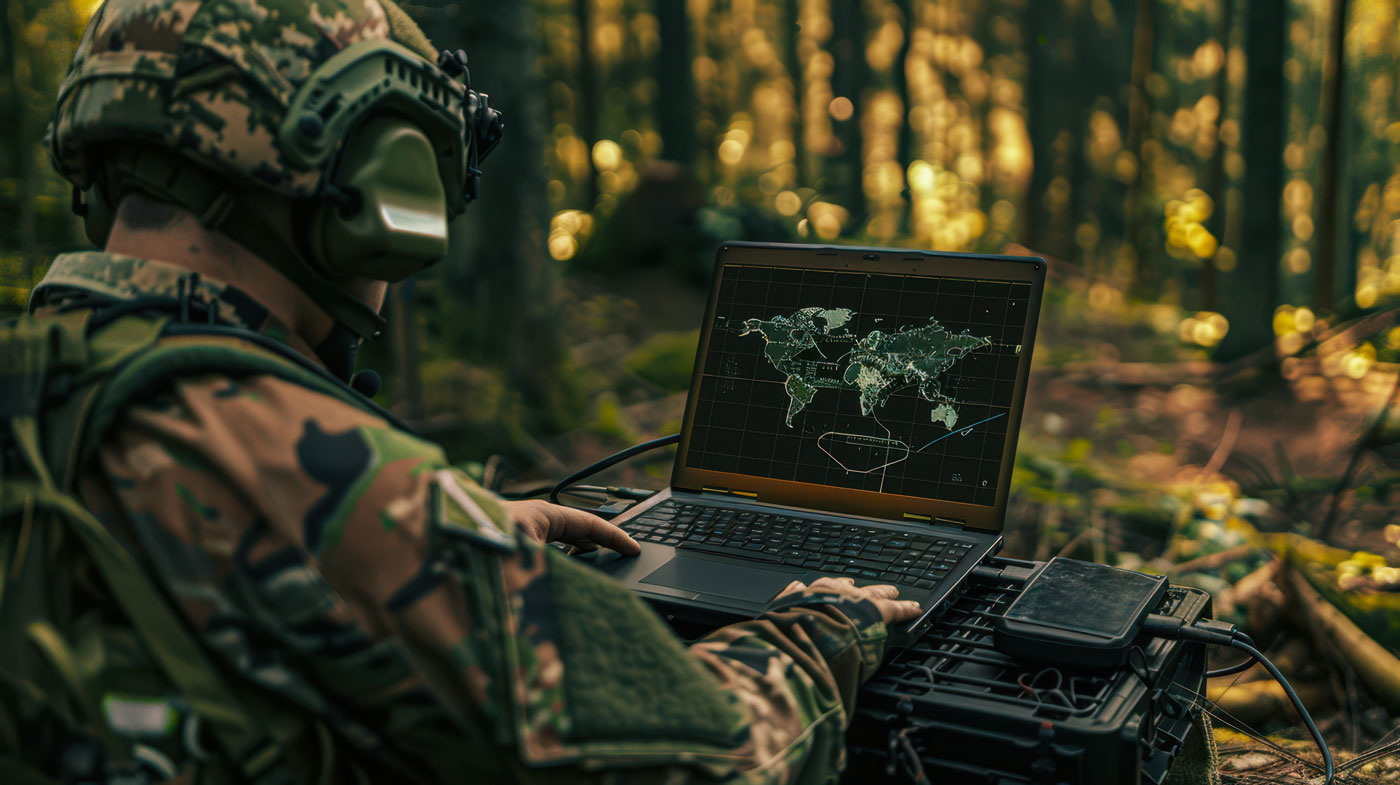
How Ukraine Overcame the Transparent Battlefield to Achieve Operational Surprise in Kursk
Dorsel Boyer and ISC Robert K. Becker
In August, Ukraine launched an offensive into the Kursk Oblast that surprised Russia, given the pervasiveness of surveillance on the modern battlefield. The Ukrainian incursion demonstrated that operational surprise is still possible in the Ukraine conflict by avoiding and degrading Russian ISR.
After 18 days of fighting, Ukrainian forces had occupied 490 square miles of Russian territory and continued to gain ground each day.i

The proliferation of unmanned aerial systems (UAS) in the Ukraine-Russia war has created a transparent battlefield marked by near-persistent surveillance, making operational surprise difficult to achieve. Several factors contribute to battlefield transparency in Ukraine, including the proliferation of small commercial UAS, which create near-persistent surveillance, preventing Ukraine and Russia from gathering sufficient mass to conduct combined arms maneuvers. Without the ability to maneuver, conditions along the front have devolved into grinding positional fighting. Russian forces have relied on small groups of assault infantry to wear down Ukrainian defenders in static attritional warfare. These prevailing conditions caused many observers to believe that opportunities to achieve operational surprise and resume maneuver warfare are limited in contemporary conflict.
Factors Driving the Ukrainian Offensive in Kursk
Ukraine launched the offensive with several political and military objectives in mind. The primary political objective was to increase Kyiv’s diplomatic position in future negotiations. The attack also allowed Ukraine to capture Russian soldiers to facilitate prisoner-of-war exchanges. Operationally, Ukrainian commanders sought to enable deep targeting of Russian airfields that launch glide bombs into Ukraine and hoped to force Russian commanders to move forces from the ongoing fight near Pokrovsk to reinforce in Kursk. Ukraine also sought to challenge Russia’s logistics networks supporting ongoing operations in the Kharkiv oblast.
Ukraine focused its counteroffensive on Kursk because Russia’s ISR capability, indirect fire systems, and defensive positions there were less capable than in other sectors along the front. Reporting on unit locations indicated Russia was accepting operational risk by reducing defensive capability in Kursk, likely an essential part of Ukraine’s calculus during planning. Poorly trained and ill-equipped Russian conscript soldiers occupied Kursk; the few conscripts present could not effectively defend existing obstacle belts.ii The lightly defended border area and largely intact road network in the Sumy and Kursk oblast provided space for rapid advance, unlike the heavily mined and fortified Zaporizhzhia regions and Donetsk in eastern Ukraine.iii
Russia had positioned most of its ground forces in eastern Ukraine, leaving northern Ukraine with few Russian troops defending the border. Recent open-source exploitation indicates that up to 75 percent of Russia’s ground forces, airborne units, and naval infantry are deployed in or near eastern Ukraine. As a result of this significant troop commitment, Russia was forced to compromise on defending Russian territory.iv Russia had moved troops from the newly formed Leningrad Military District to support offensive operations in Kharkiv and Donetsk oblasts.v Russia also reduced troop presence along the border with Ukraine outside the current combat zone.vi
Russian leaders likely accepted greater risk in the Kursk area, believing the threat of nuclear weapons would prevent an incursion onto Russian land. Russia has historically stated that Russia’s territorial integrity was a nuclear red line.vii
Shaping Operations Critical to Surprise and Sustaining the Offensive
Ukraine achieved surprise in the Kursk region through secrecy and careful intelligence preparation of the battlefield. Reporting indicates that the Ukrainian Army conducted reconnaissance to identify weaknesses in Russian defenses along the Russia-Ukraine border. Once intelligence was collected and analyzed, the Commander-in-Chief of the Armed Forces of Ukraine, General Oleksandr Syrskiy, led the planning with only a few senior officers in attendance.viii The planning sessions were likely conducted face-to-face to prevent the risk of Russian cyber actors or signals intelligence from discovering the plan. Press interviews with Ukrainian soldiers indicate that the incursion forces were not notified until hours before the operation.ix
Ukrainian deception and camouflage were vital to preventing Russian commanders from assessing an attack was imminent. At the outset of planning, Ukrainians chose a quiet sector of the front that would have provided logistics and transportation links into both the Kharkiv area and Kursk to obscure the purpose of Ukrainian forces concentrating in the area. Ukraine also conducted a disinformation campaign, with Ukrainian military and political leaders messaging about their inability to conduct counteroffensive operations before spring 2025. Ukraine’s military announced the 61st Mechanized Brigade would be moving to Vovchansk, a city in the northern sector of the fighting in eastern Ukraine. Even after the 61st was told they would go into Russia, senior officers in the unit thought it was a bluff to deceive the Russians.x
Ukraine successfully employed air defense systems to reduce Russian ISR. The Ukrainian military’s effective targeting of Russian UAS and striking of Russian airfields to apply pressure on the Russian Aerospace Forces created temporary local relief from persistent surveillance, enabling aerial and fires interdiction. Ukrainian air defenders and UAS operators used first-person view drones as an air defense system, targeting Russia’s primary reconnaissance drones, such as the Orlan system.xi Ukrainian UAS unit OMEGA M2 released several videos of the successful targeting of Russian ISR drones in support of the counter-UAS campaign.xii Additionally, Ukrainian forces did not have to contend with the saturation of small UAS experienced in more active sectors of the front during the preparatory and initial phases of the operation.
Ukraine also used electronic warfare (EW) to degrade Russian C4ISR, while Russian EW systems were not as dense in Kursk as in other sectors of the line of contact. Most of the available reports concerning EW are from Russian military bloggers and, therefore, are likely biased and not representative of the full picture.xiii However, the tenor of the reports indicates disarray in command, control, communications, and ISR at the beginning of the operation.xiv Russian units in the region were equipped with domestically produced drones, which may have been less protected against EW than similar devices. Training and experience deficiencies among the largely conscript drone operators likely exacerbated material shortcomings in quality and quantity. Similarly, Russia had fewer active EW systems in Kursk because Russia did not anticipate such an assault. Because Russia did not expect an attack there was less degradation of communications and navigation aids for political and economic reasons.
Ukraine employed preparatory fires to hinder Russia’s ability to respond to the incursion rapidly. Shaping fires that supported the operation included deep drone strikes against Russian airfields used to launch glide bomb attacks and tactical aviation land fuel storage tanks.xv The targeting of airfields limited Russian Aerospace Forces to conduct reconnaissance and respond to the incursion with tactical aviation. Ukraine also used rocket artillery systems provided by the West to target key Russian positions and deploy scatterable mines along the flanks of the advance. Ukrainian fires also disrupted command and control and effectively countered Russia’s response by interdicting reinforcements.xvi
Implications for the U.S. Army
The Ukrainian incursion into the Kursk region demonstrated that operational surprise is still possible in the Ukraine conflict by avoiding and degrading ISR—a lesson that could broadly be applied to future large-scale combat operations in other theaters as well. The operation shows that, to achieve operational surprise, many factors must be executed with a precision that may challenge even the most experienced staff.
- Intelligence preparation of the battlefield and supporting reconnaissance synchronization must identify the geography, infrastructure, and enemy force dispositions most suitable for exploitation by available forces.
- Intelligence support planning and reconnaissance synchronization require compartmentalization for high-risk operations to prevent counterintelligence risk and support deception planning.
- Terrain and vegetation are essential to the concentration of combat power. Using terrain and foliage to conceal assembly and rehearsal areas can deny the enemy from acquiring indicators of an impending attack.
- Preparatory fires are an important component of shaping operational objectives while simultaneously enabling surprise by temporarily degrading enemy ISR and deep strike capability. Nonlethal fires, such as information operations, can deceive the enemy regarding the focus of upcoming operations.
Notes
_______________________________________
[1] Josh Holder, “Mapping Ukraine’s Surprise Invasion of Russia,” The New York Times, August 23, 2024, https://www.nytimes.com/interactive/2024/08/23/world/europe/ukraine-russia-kursk-invasion-map.html.
[2] Moscow Times Reporter. “Russia’s Use of Inexperienced Conscripts for Kursk Defense Raises Questions.” Moscow Times, August 14, 2024. https://safe.menlosecurity.com/doc/docview/viewer/docN6DC239074B5Dc44dc3e0c37c150391297c13794cb36e83d1f0a59119b9c8569bdde3d6034356.
[3] 1. Kwan Wei Kevin Tan, “Https://Www.Msn.Com/En-Us/News/World/Zelenskyy-Said-Ukraine-Told-No-One-about-the-Kursk-Invasion-Because-Its-Allies-Would-Have-Called-It-Unrealistic/Ar-AA1p5w4K?ocid=BingNewsSerp,” MSN, August 20, 2024, https://www.msn.com/en-us/news/world/zelenskyy-said-ukraine-told-no-one-about-the-kursk-invasion-because-its-allies-would-have-called-it-unrealistic/ar-AA1p5w4K?ocid=BingNewsSerp.
[4] The Associated Press, “Ukraine’s Swift Push into the Kursk Region Shocked Russia and Exposed Its Vulnerabilities,” AP News, August 16, 2024, https://apnews.com/article/russia-ukraine-war-kursk-incursion-putin-1178b99b32b476816db3a48ffa06b11a.
[5] Oleksandra Bashchenko, “Russia Moves Nearly All Troops on Finnish Border to War against Ukraine,” RBC News, July 2024, https://www.msn.com/en-us/news/world/russia-moves-nearly-all-troops-on-finnish-border-to-war-against-ukraine/ar-BB1owIlf.
[6] Deutsche Welle, “Ukraine: Kyiv Partially Halts Russian Offensive in Kharkiv – DW – 05/17/2024,” dw.com, May 17, 2024, https://www.dw.com/en/ukraine-updates-kyiv-partially-halts-russian-offensive-in-kharkiv/live-69105468.
[7] Lawerence Freedman, “The Russo-Ukrainian War and the Durability of Deterrence,” The Russo-Ukrainian War and the Durability of Deterrence, December 11, 2023, https://www.iiss.org/online-analysis/survival-online/2023/12/the-russo-ukrainian-war-and-the-durability-of-deterrence/.
[8] Dickinson, Peter. “Ukraine’s Kursk Offensive Proves Surprise Is Still Possible in Modern War.” Atlantic Council, August 14, 2024. https://www.atlanticcouncil.org/blogs/ukrainealert/ukraines-kursk-offensive-proves-surprise-is-still-possible-in-modern-war/.
[9] “Russia’s Double-Punch Back against Ukraine’s Shock Raid,” The Economist, August 18, 2024, https://www.economist.com/europe/2024/08/18/russias-double-punch-back-against-ukraines-shock-raid.
[10] Marson, James. “Ukraine General’s Plan Surprised the Russians—and His Own Troops.” The Wall Street Journal, August 31, 2024. https://www.wsj.com/world/europe/ukraine-general-oleksandr-syrskiy-russia-kursk-incursion-32965fb9?mod=Searchresults_pos8&page=1
[11] “ТРОЙКА 
[12] Hambling, David. “Ukraine Fields FPV Interceptor Drones at Speed.” Forbes, July 4, 2024. https://www.forbes.com/sites/davidhambling/2024/07/02/ukraine-fields-fpv-interceptor-drones-at-speed/.
[13] David Hambling, “Ukraine’s Kursk Offensive Blitzed Russia with Electronic Warfare and Drones,” Forbes, August 12, 2024, https://www.forbes.com/sites/davidhambling/2024/08/09/ukraines-kursk-offensive-blitzed-russia-with-electronic-warfare-and-drones/.
[14] WarTranslated (Dmitri) on X: “Additional Russian evidence of serious electronic warfare preparation by Ukrainian forces before the incursion in Kurks, which completely suppressed communications within the Russian troops. https://t.co/wv3uVGFlM5” / X
[15] Sharp, Alexandra. “Ukraine Pushes Farther into Kursk as Drone Strikes Target Russian Airfields.” Foreign Policy, August 14, 2024. https://foreignpolicy.com/2024/08/14/ukraine-kursk-incursion-russia-airfields-drone-strikes-kishida-japan/.
[16] Andrew E. Kramer, “Ukraine’s Push into Russia Is a Surprising Turn in the War,” The New York Times, August 8, 2024, https://www.nytimes.com/2024/08/08/world/europe/russia-border-ukraine.html.
Distribution A: Approved for public release
How Ukraine Overcame the Transparent Battlefield to Achieve Operational Surprise in Kursk
Dorsel Boyer and ISC Robert K. Becker
File Size:
1.14MB
File Type:
Page Count:
5


